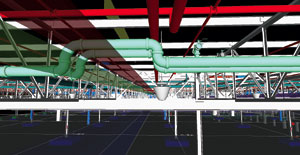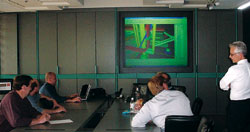 |
 |
| No-Fly Zone. Facilities owns the space a foot above the top chord, production owns the floor. (Images courtesy of General Motors) |
"Its a breakthrough change in the way we do business," smiles August Olivier, GMs director of capital projects. He was talking about two automotive plants under construction in Michigan that take the idea of virtual design and construction roaring down the road.
"Its a schedule-driven innovation," Olivier says. Schedule for GM means time-to-market. That takes fast movement from decision to productionand not just of cars, but also of the dedicated plants to build them. Compressing plant design and construction cycles lets GM hold off on facilities commitments as long as possible while the car culture decides what it wants. Shortening the cycle mows down the chaos inherent in predicting the market and designing and building plants to meet it.
 |
|
Resolving Issues. Mauck (above, right) in 3-D design review, where conflicts were solved. (Photo courtesy of Ghafari Associates) Click here to view diagram |
"All the stars aligned," says Robert J. Mauck, vice president of advanced technologies at Ghafari Associates LLC, Dearborn, Mich. Ghafari is an the architectural/engineering firm and technology integrator. It has worked with Detroit-based GM for four years to bring just-in-time supply chain technologies to facilities construction. Ghafari has helped vet technology, techniques and organization needed to turn the dream into reality. "GM laid the groundwork and then pulled the trigger on all the right things," Mauck says.
The gains realized are the classics sought by the industry: faster, better, cheaperand saferconstruction, claims Mauck and others on the team.
 |
| V6. Comprehensive 3-D modeling cuts clutter and activity on site. Parts arrive cut to fit. No trash, no dumpsters. (Images courtesy of General Motors) |
They say the gains are being delivered on the two signature projects in Michigan: a 2.4-million-sq-ft vehicle assembly plant in Lansing called Lansing Delta Township, or LDT plant, and a 442,000-sq-ft addition to a Global V6 engine plant in Flint.
The Flint plant has flown together in 24 weeks less than the typical 85-week design and construction time. It is finishing construction five weeks ahead of schedule with no change orders from building component interferences.
Of the two plants, Flint gets a lot of the glory for near perfect performance. But LDT has been the plowhorse for de-bugging the organizational techniques and integrating the critical 3-D design technology, says Jack Hallman, GMs director of manufacturing construction management. "Everyone likes to talk about Flint because it has been such a smooth job," Hallman says. "But I think LDT should get as much credit as Flint, with all the learning we did on that. We learned some tough lessons to make it work, and it is working now as well on LDT as it has on Flint."
What is working out well are design-build teams that are saving money and time and accomplishing the projects with the offsite fabrication and just-in-time delivery techniques of lean construction. They are each enabled by a commitment to build from comprehensive 3-D models that not only define facility geometry but have been refined by a team with fully incorporated structural, mechanical and electrical details.
In the case of V6, the design-build team perfected the 3-D model and mutually resolved every interference prior to starting construction. Then, they "locked the model" and all parties agreed to build it as planned. Any unapproved deviation would be on that subcontractors head.
"In 26 years I have never seen a project run with more collaboration and be so simple," says Michael Neville, Ghafari vice president and project principal. Ghafari is the V6 project manager and model coordinator. Barton Malow Design, Southfield, Mich., is architect and Ideal Contracting LLC, Pontiac, Mich.,a minority contracting firm in which of Barton Malow owns a 49% share, is general contractor.
Hallman says the lessons learned on LDT have made a tremendous difference with V6. "We got off to a rocky start at LDT, but that was the learning curve. If we hadnt done LDT, Flint would have never been," Hallman says.
"I think the integration is outstanding," Hallman adds. "I have been a proponent of lean construction, of taking the lean techniques we have used to improve our efficiency in manufacturing, for a long time. I have seen these things work and work great, and I have been pushing through industry groups like the Construction Industry Institute and the Construction Users Round Table. What 3-D has done is be an enabler for lean construction, and it really started at LDT."
The early stumbles at LDT came from a hesitancy to commit and from some software issues, he says. But once those problems were resolved, that projectand V6 which followedsoared. "We didnt trust the 3-D data," Hallman admits. "We cut our teeth on LDT."
Todd A. Pugh, estimator at John E. Green Co., Highland Park, Mich., mechanical contractor on both projects, agrees: "No one, quite frankly, really bought into the model when we started in that [LDT] job. But by the time the V6 project came around, that had all changed. We had the entire job detailed and coordinated before we stepped on the jobsite," Pugh says. "It wasnt perfect, because of human errors wed made, but they were very minor things."
"With owners like GM taking the lead, other owners will see the benefit," predicts Lawrence F. Kurth, engineering and safety manager for Douglas Steel Fabricating Corp., Lansing Mich., steel fabricator for the V6 plant. Ghafari was the structural engineer for both the LDT and V6 plants. "It will spread to the industrial world first," Kurth says, but cautions, "It wasn't easy... the software doesn't solve the problems, it's the team's willingness to work."
How It Works
By now the technology of 3-D modeling and data-rich design may be familiar, but Ghafaris process for its use is not.
Bentleys ProjectWise collaboration servers were used to circulate the architects Microstation model. Everyone could see it with a free viewer. NavisWorks design reviewer and 3-D model coordinator integrated new geometry developed by subcontractors in other programs and ran collision detection on the results. Software included SDS/2 for steel detailing, QuickPen for mechanical planning, InteliCAD for HVAC and Autocad and various Autocad third-party products, says Samir Emdanat, Ghafaris manager for advanced technologies. He says NavisWorks doesnt always bring in every bit of associated data, but it brings in enough. "Its the best you can do with the supply chain right now," he says.
"In the last few years weve been focused on the supply chain and what gets to the bottom line," says Mauck. "Its not technology for technology sake."
"We could have done V6 two years ago," adds Emdanat. "The technology hasnt changed. The steel detailers were already there....We might not have had the same level of sophistication for the piping and HVAC, but we could still have done the coordination piece."
Emdanat says the key is making it all available to the full team. "Its not simple. Its not out-of-the-box. You need to know the standards really well. It all hinges...
eneral Motors Corp.s World Wide Facilities Group has taken the leap and rather than fall, it has flown. The GM staff who build the plants that make cars that roll all over the world decided to lock in plant designs as virtual models and then tell the contractors: "Go build THAT!"
Post a comment to this article
Report Abusive Comment